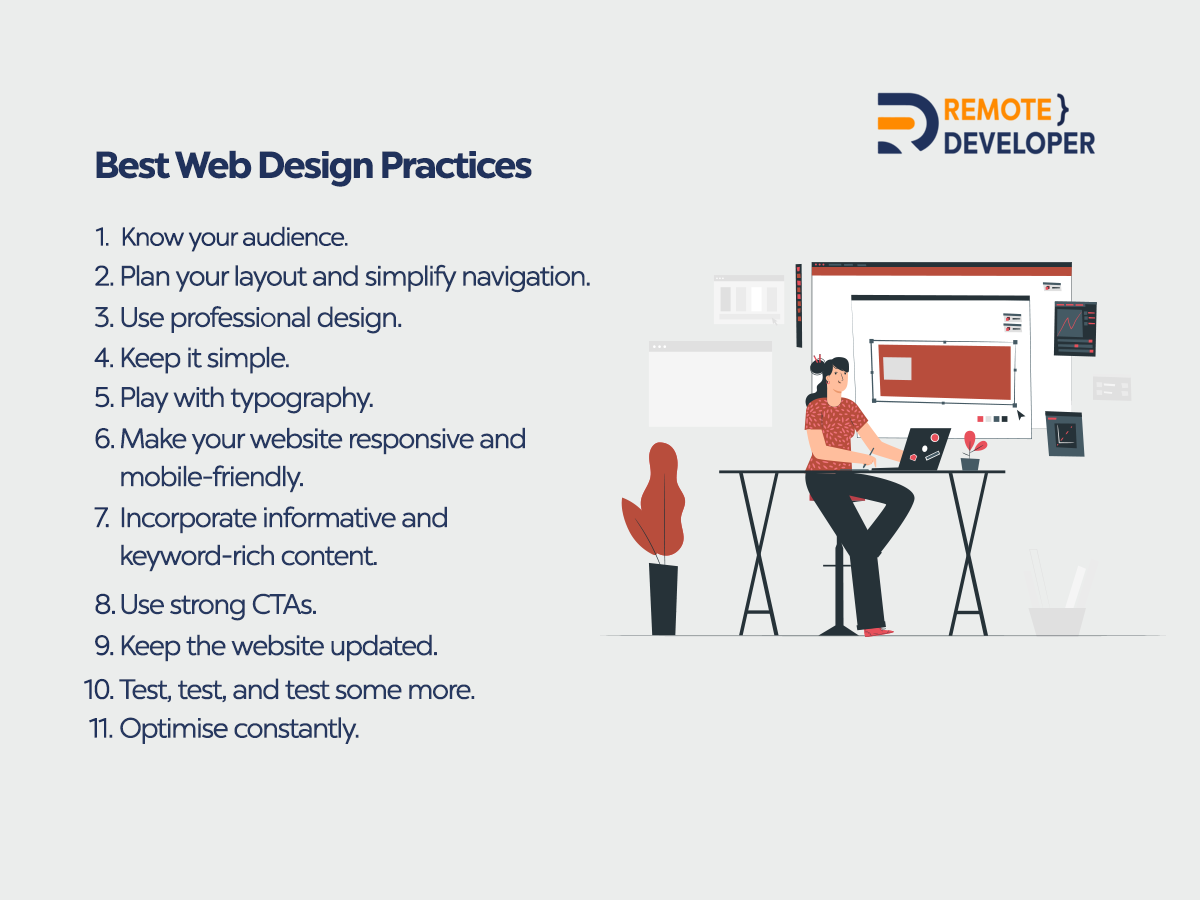Developing and designing a website can be an extremely effective way to increase a company’s revenue. When it comes to improving web design, there are three main factors that businesses should focus on in order to maximise their earnings: the layout of the website, the content, and the calls to action.
The layout of a website is important because it can influence how users interact with the site. Studies have shown that websites that are easy to navigate tend to generate more revenue than those that are not.
Poor web design can have the opposite effect and cause customers to leave a website without making a purchase. In this article, we will be going over web design strategies to increase revenue.
Know your audience
One of the most important aspects of being a successful business is understanding your customers and what they want. This means not only knowing who they are but also understanding their needs and what drives them. For many businesses, this starts with improving web design, which consequently improves your sales.
Your website is often the first impression potential customers have of your business, so it’s important to make sure it looks professional and reflects your brand identity. But beyond that, you also need to make sure it’s easy to use and provides the information people are looking for.
If you’re not sure who your target audience is or what they want, do some research. Use surveys, focus groups, or interviews to get feedback from current and potential customers. This will help you understand what motivates them and what kinds of content they’re interested in.
Plan your layout and simplify navigation
Your website’s layout is important for two reasons. First, it determines how easy your website is to navigate. Second, a well-designed layout can make your website look great. There are a few things you can do to improve your web design and make sure your website is easy to navigate.
Make sure all of your pages are easy to find. Place links to your main pages at the top of every page, and include links to your subpages on each main page. Site visitors can then find the information they’re looking for much quicker and easier. Simplifying navigation keeps visitors on your site longer and reduces bounce rates.
Don’t forget to use a clear and consistent layout throughout your website. Use the same fonts, colours, and design elements on all of your pages. This will help create a unified look for your website.
Use professional design
When potential customers visit your website, the first thing they’ll notice is the design. If it looks amateurish or unprofessional, they’re likely to move on. However, if your website has a professional design, it will look credible and trustworthy. This will improve your chances of making a sale or getting a new client.
There are many factors that contribute to a professional web design. As mentioned earlier, the layout should be easy to navigate, and all of the text and images should be properly formatted. The colours and fonts should also be consistent throughout the site. Most importantly, the website should be responsive so that it looks good on all devices.
Images and graphics can also help communicate your message and add visual interest to your website. However, you should use them wisely – too many garish images can distract from your message or make your website look cluttered. You should also choose colours that represent your brand and match the tone of your website. Too many colours can be distracting, so use them sparingly.
Keep it simple
In web design, less is often more. You don’t want to overload your website with too much information, which can make it difficult for visitors to find what they’re looking for. Instead, focus on the essentials and keep things simple. This will make your website simpler to navigate and more user-friendly.
You also don’t want to clutter your pages with a lot of graphics and animations. These can slow down your website and cause it to load more slowly. Instead, use clean, simple designs that focus on the content. This will make your website more visually appealing and easy to read.
In addition, you should avoid using too many fonts or font sizes on your website. This can also make it difficult for visitors to read the text. Stick with a few basic fonts that are easy to read, and use a consistent font size throughout your website, which brings us to our next point.
Play with typography
Font selection is an important part of good web design. Typography can be used to create a clear hierarchy of information and to reflect your brand.
Different fonts can be used for headings, subheadings, and body text to create a visual hierarchy on the page. You can also use different fonts for your logo and other branding elements.
When selecting fonts, it’s important to choose ones that are easy to read. Serif fonts are generally considered easier to read than sans serif fonts. You should also avoid using too many different fonts on a page. Using too many different fonts can make the page look cluttered and confusing.
It’s also important to consider the font size. The font size should be large enough so that it’s easy to read on different screen sizes, but not so large that it takes up too much space on the page.
You may also want to consider using typography to reflect your brand. If you have a fun or playful brand, consider using a fun or playful font for your headings and body text.

Make your website responsive and mobile-friendly
An important aspect of creating a website is making sure that it looks great on all devices. No matter what size screen someone is using, your website should be easy to navigate and look great. There are a few ways to improve your web design so that it looks great on all devices.
One way to make your website responsive is to use media queries. Media queries allow you to change the layout of your website based on the size of the screen. You can also use them to change the font size and other aspects of the website’s appearance.
Another way to make your website responsive is to use percentages instead of pixels. With percentages, you can control the width and height of elements on your page using relative values. This will help your website look good on all devices, regardless of their screen size.
If you want to make sure your website design is effective for all users, then you need to focus on designing websites that are mobile-friendly. This means making sure the website can be easily accessed and used on smartphones and other mobile devices. There are many ways to improve web design for mobile devices, including using responsive design techniques, flexible images and videos, and simpler layouts.
If most of your customers are using their phones to make transactions, it’s crucial that your website be easy to navigate on a small screen. Many people now expect websites to be responsive, meaning they automatically adjust depending on the device being used. If your site isn’t mobile-friendly, you’re likely to lose customers and revenue.
Incorporate informative and keyword-rich content
When you think about it, the majority of people who are looking for a business will go to the internet and do a search. If your website doesn’t show up on the first page of the search engine results pages (SERP), then you’re losing out on potential customers.
Hence, it is crucial that you work on creating high-quality content to go with the design. Make sure all of your content is high quality and relevant to your target audience. The more relevant and valuable your content is, the more likely people are to click through to your website from the SERPs.
Focus on creating informative and keyword-rich content. When done correctly, this will help to improve your site’s visibility and organic search traffic.
Plus, it is never a bad idea to learn the art of white-hat SEO. White-hat SEO is a set of techniques that focus on improving your website design and providing valuable content to your users. While white hat SEO takes longer to see results, it is a more sustainable approach that will not get you penalised by the search engines. It ultimately leads to better user engagement and more valuable content.
Use strong CTAs throughout the website.
Make sure your web design includes calls to action (CTAs) that encourage visitors to convert. CTAs can be placed throughout your site, but they are most effective when placed near the relevant content.
Use clear and concise language, and make sure the CTA button is easy to see and click. Be sure to test different versions of your CTAs to see which ones generate the most conversions.
Keep the website updated
Web design is constantly evolving, and it’s important to keep your design up to date with the latest design trends and technologies. If you don’t, your website may start looking dated and people may not take you seriously. There are many new trends and technologies to choose from, so how do you know which ones to use?
This goes back to the first point. Always consider your audience. What do they want? What do they need? What are their preferences? Once you have a good understanding of your audience, you can start incorporating new trends and technologies that will appeal to them.
You don’t have to use them all, but using a few can help improve your web design and keep it looking fresh.
Some of the latest trends and technologies include responsive design, parallax scrolling, HTML5, CSS3, and Bootstrap.
Test, test, and test some more
Creating a website that is both appealing and easy to use for all visitors is essential for any business. Too often, businesses focus on web design elements that only a portion of their audience will see. By neglecting to test their website on a variety of devices, businesses may be inadvertently excluding potential customers.
It is important to test your website on a variety of devices in order to ensure that it is accessible and functional for all users. This can include using different browsers, operating systems, and screen sizes. You can use online tools or actual devices to test your site.
Make sure all links are working properly and that the site is easy to navigate. Check for any broken images or fonts. If you have a responsive design, be sure that it looks good and functions properly on all devices. The more tests you run, the better your website will function for all visitors.
Testing your website on different devices will help you identify any areas that need improvement. It can also help you determine which design elements are most effective for different audiences. By ensuring that your website is accessible and functional for all users, you can improve your chances of attracting more customers.
Optimise constantly
In today’s world, more and more people are using smartphones and tablets to access the internet, so it’s important that your website is designed to look great and function well on those devices. Improve your website by making sure it loads quickly on all devices.
There are several ways to optimise your website, including making sure your images are small enough to load quickly, using a responsive design that adjusts automatically to different screen sizes, and testing your website on different mobile devices.
If you’re not sure how to do these things yourself, there are plenty of online resources available that can help. By optimising your website, you can ensure that as many people as possible can see it and enjoy its contents.
The Bottom Line
By following the tips provided in this article, you can boost your revenue with your web design. Remember to keep your design clean and user-friendly, focus on your target audience, and use effective calls to action.
A well-designed website will result in increased traffic and conversions, which will result in more sales and higher profits. Good luck!
Check out our website to learn more about web design, the latest trends, and technology!

